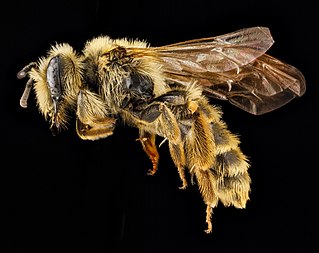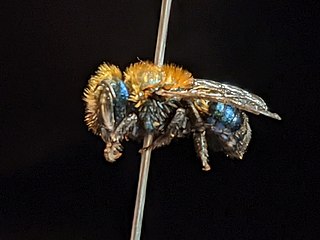
Megachilidae is a cosmopolitan family of mostly solitary bees. Characteristic traits of this family are the restriction of their pollen-carrying structure to the ventral surface of the abdomen, and their typically elongated labrum. Megachilid genera are most commonly known as mason bees and leafcutter bees, reflecting the materials from which they build their nest cells ; a few collect plant or animal hairs and fibers, and are called carder bees, while others use plant resins in nest construction and are correspondingly called resin bees. All species feed on nectar and pollen, but a few are kleptoparasites, feeding on pollen collected by other megachilid bees. Parasitic species do not possess scopae. The motion of Megachilidae in the reproductive structures of flowers is energetic and swimming-like; this agitation releases large amounts of pollen.

Mason bee is a name now commonly used for species of bees in the genus Osmia, of the family Megachilidae. Mason bees are named for their habit of using mud or other "masonry" products in constructing their nests, which are made in naturally occurring gaps such as between cracks in stones or other small dark cavities. When available, some species preferentially use hollow stems or holes in wood made by wood-boring insects.

Theodore Dru Alison Cockerell (1866–1948) was an entomologist and systematic biologist who published nearly 4,000 papers, some of them only a few lines long. Cockerell's speciality was the insect order Hymenoptera, an area of study where he described specimens from the United States, the West Indies, Honduras, the Philippines, Africa, and Asia. Cockerell named at least 5,500 species and varieties of bees and almost 150 genera and subgenera, representing over a quarter of all species of bees known during his lifetime. In addition to his extensive studies of bees, he published papers on scale insects, slugs, moths, fish scales, fungi, roses and other flowers, mollusks, and a wide variety of other plants and animals.

Thyreus is an Old World genus of bees, one of many that are commonly known as cuckoo bees, or cloak-and-dagger bees, and are kleptoparasites of other species of bees, mostly in the genus Amegilla. They all have strongly contrasting patterns of coloration – three species from the Sydney region, Thyreus nitidulus, T. lugubris, and T. caeruleopunctatus are bright blue and black.

Grace Adelbert Sandhouse (1896–1940) was an American entomologist.

Sphecodes is a genus of cuckoo bees from the family Halictidae, the majority of which are black and red in colour and are colloquially known as blood bees. Sphecodes bees are kleptoparasitic on other bees, especially bees in the genera Lasioglossum, Halictus and Andrena. The adults consume nectar, but because they use other bees' provisions to feed their offspring they do not collect pollen.

Osmiini is a tribe of leafcutter, mason, and resin bees in the family Megachilidae. There are about 19 genera and at least 1,000 described species in Osmiini.

The death camas miner bee or death camas bee, is a species of miner bee in the family Andrenidae. It is found in North America. It specializes in feeding on the highly poisonous Toxicoscordion venenosum, the meadow deathcamas, and close relatives. It is quite likely the only bee that can tolerate the deathcamas toxin, zygacine.

Osmia cerasi is a species of mason bee found in the southwestern United States and northern Mexico.
Osmia adae is a species of bees within the genus Osmia, also known as mason bees, in the Megachilidae family.
Osmia alaiensis is a species of bee in the family Megachilidae. It was described by Van der Zanden in 1994.

Osmia albiventris, also known has the white-bellied mason bee, is a species of bee native to Canada. It belongs to the genus Osmia and the family Megachilidae. Like most Osmia bees it is a solitary bee.
Osmia alfkenii is a species of bee native to the West Palearctic. Its regional distribution is in the regions of Béni Mellal-Khénifra Drâa-Tafilalet and Souss-Massa It was described by Adolpho Ducke in 1899.
Osmia aliciae is a species of bee in the family Megachilidae.
Osmia angustipes is a species of mason bee from the family Megachilidae. It is found in North America and was discovered in 1933 by Cockerell.
Osmia argyropyga is a species of mason bee native to Africa, Europe and Asia. It was described by Pérez in 1879.
Osmia atroalba is a species of insect in the bee clade and the genus Osmia. It was scientifically description in 1875 by Morawitz.
Osmia atrocyanea, the large indigo mason bee, is a species of mason bee native to North America. It was scientifically described in 1897 by Cockerell.
Osmia ausica is a species of bee from the Osmia genus native to Southern Africa. It was scientifically described in 1944.










